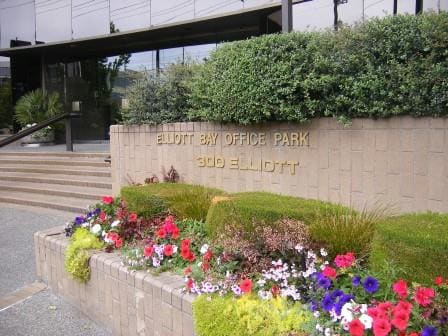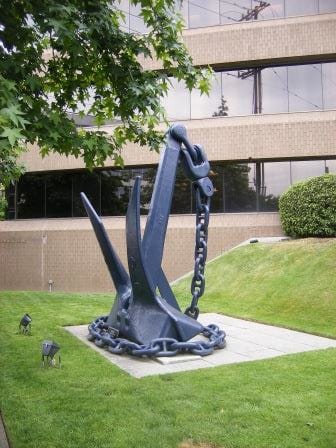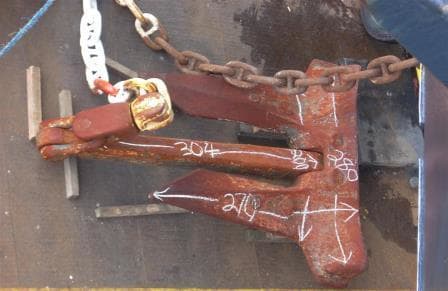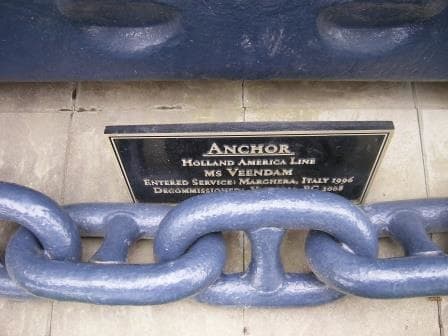 Before we go inside there are two other items of interest. First off all, the building has an official name and that is: Elliott Bay Office Park. That was a new one to me as well, as most people simply refer to it as the Holland America Building. Courtesy of the fact that the companies name is on big letters on the front of the building. But as there are other companies having offices inside, I suppose calling it the Holland America Building would not be correct, however nice it may sound.
Before we go inside there are two other items of interest. First off all, the building has an official name and that is: Elliott Bay Office Park. That was a new one to me as well, as most people simply refer to it as the Holland America Building. Courtesy of the fact that the companies name is on big letters on the front of the building. But as there are other companies having offices inside, I suppose calling it the Holland America Building would not be correct, however nice it may sound.
Then on the East front side of the building is a small grassy area with on it an anchor. This is an old Veendam anchor and was installed in 2008. As yours truly was somewhat involved with that, it is a nice story to tell. This anchor was rejected for its purpose by Lloyds Register as one of the flukes was bent. While sailing all over the world, we always have a large number of anchor ports in the schedules. Before we anchor we study the navigational charts and try to pick the most suitable anchorage based on what the chart is telling us. Favorite is water with a depth of 30 meters or so and with a sandy bottom. That is of course not always available and sometimes we just have to make do with anything that goes, that is safe and what is as close to the port entrance as possible. Every Captain will do his best to keep the tender distance between ship and shore as short as possible. That does not always work. There might be more ships, the water might be too deep, close to the port, or if the port authorities are assigning designated anchorage areas and we just have to go there. There are even ports in the world where we are required to anchor right on top of a garbage dump. Then it is always interesting to see what comes up when the anchor is being retrieved. I had it once that we picked up a model T Ford car, albeit beyond salvage, so we let it go again.
Apart from picking up debris, an anchor can also get stuck in the sea bottom. There might be cracks or crevasses under the soil or it might get looped around a large piece of rock. The only way to then get the anchor out it, is to “run it over the top” which means the ship steams forward and tries to flip the anchor over and break the flukes out of – whatever it is holding it – That means that sometimes a fluke (that is one of the hands of the anchor) breaks off, or both flukes break off and only the anchor shaft appears above water. It does not happen very often, about once in the 10 years of a captain’s career , and it is getting less and less as well, as more and more cruise ports are improving their docking facilities.
During one of these break- out exercises the Veendam anchor did come loose but with a bent fluke. I was on leave from the Veendam at the time but when I returned, the ship was sailing with an anchor half out of the hawse pipe, waiting for a new one. Our spare anchor had been given to another ship sometime before and our new spare anchor was still being cast in Italy. A bent fluke does not affect safe anchoring very much but it is not ideal to sail around with it half out of the hawse pipe, if you expect bad weather. So while we were sailing the Alaska season, a solution had to be found before the Veendam was coming south again and back into the Pacific Ocean.
After hanging partly outside the hawse pipe, the sea water had taken care of removing most of the paint and turning it into a nice and rusty red. The markings indicate the plan by the shipyard to start a straightening program.
Plan A was to have the fluke straightened. A Vancouver shipyard came to have a look and it would be no problem for them. There was however an issue and that is when you try to straighten a fluke of an anchor that has been cast, it loses some of its strength. The best way is to re-forge such an anchor or anchor fluke. Well, a foundry was not available so the decision was that we needed a new one. That one eventually arrived, by ship from Italy to Miami and then by Flatbed truck all the way to Vancouver. Here it was duly installed and then the question popped up: what to do with the old anchor?
Well, most shipping offices have some sort of nautical focus point outside their premises and that was something that Holland America was lacking. Hence an executive decision was made to bring the anchor to Seattle, spruce it up and install it outside the Head Office. And here it has been since Autumn 2008.
During my next blog we are going inside the building.




June 10, 2014 at 5:18 pm
Thank you for sharing the story! I always see it on my drive home in the evening (although, sometimes the sunset is distracting or the rain&dark makes it hard to see, or the traffic conditions require full attention….) And I was wondering what the reason was.
June 10, 2014 at 11:29 pm
Good to see you posting again Capt. 🙂 All the best in your new assignment!
June 11, 2014 at 2:08 am
That was very interesting about the Anchor, thank you, nice to see what the Head Office looks like as well.
June 11, 2014 at 9:06 pm
Ah! This is the detailed narrative style of Capt. Albert’s writing I’ve missed! Glad to see it again. Thank you for writing about little tidbits of HAL folklore like this – looking forward to more (and to seeing the inside of the building).
June 16, 2014 at 9:30 pm
I’m a “ditto” to ‘barbara r’s comment, Captain. It takes talent to make a story about a ANCHOR so interesting as you did! Your last ship (the Statendam) has, to my delight, returned with 5 familiar faces, no less! Thanks to a family connection of two officers on board. Your Hotel Manager turned Hotel Director is back on the ship too. Reading onward on your blog …
June 29, 2014 at 3:33 pm
Finally you made it to Seattle. It is really interesting to read about Seattle. I hope you will go to all the departments. Especially ship_inventory. The still use a fax!!!! I was lucky, i saved my old one, so i was able to fax them. Until now i still don t know if they received it. Maybe you can trace it. Succes with your new job.
July 9, 2014 at 4:59 pm
I have missed reading your blogs and wondered what you had been up to. I must have missed your explanation of why you are now located in Seattle. What a difference being on land it is. I’m now wondering about receiving your blog via my email, which is the way I use to receive it. I always learned so much about sea life from you and I never got bored with any of it. I’m going to miss reading those stories now unless you have other stories, such as the one you just wrote about. Anyway, I’m just glad to read anything you write about and so happy you are back again.